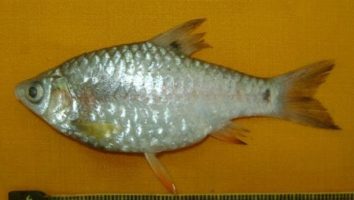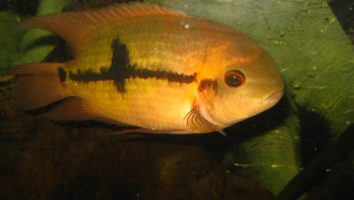The dragon goby is a beautiful and unique freshwater fish that is perfect for the intermediate fish keeper. They are not as challenging as some of the other freshwater fish out there, but they are also not as easy as goldfish.
This guide will teach you everything you need to know about dragon goby care. You’ll learn about their diet, size, lifespan, and more!
Table of contents
Species overview
The dragon goby (scientific name: Gobius ophiophagus) is a type of fish that’s native to the waters around Malaysia, Indonesia, and the Philippines.
They prefer to live in brackish or saltwater habitats where there is a lot of vegetation. This could be in the form of mangroves, seagrasses, or even coral reefs.
The dragon goby is a bottom-dwelling fish that spends most of its time hiding among the plants. This is why their natural habitats are so important to them.
These fish are known for being very hardy and are able to adapt to a wide range of water conditions. This makes them a popular choice for aquariums.
The dragon goby is a carnivorous fish that feeds on small invertebrates. In the wild, their diet consists of things like crabs, shrimp, and small fish.
Appearance

The first thing you’ll notice about this species is their large head and mouth. They have a very prominent underbite that really stands out.
The head of the Dragon Goby makes up about a third of their entire body. They have large eyes that sit on the top of their head (almost giving them a frog-like appearance).
Their bodies are long, thin, and eel-like. They have a dorsal fin that runs almost the entire length of their back and an anal fin that does the same on their underside.
The pectoral fins of the Dragon Goby are very large and fan-shaped. They use these fins to help them “walk” along the bottom of the tank or aquarium.
The caudal fin of this species is very long and thin. It’s almost whip-like in appearance and is used for steering and balance while they’re swimming.
Dragon Gobies are usually a dark brown or black color. They may have some lighter spots or stripes that help them blend in with their environment.
Lifespan
Most Dragon gobies only live for 2 to 3 years in captivity. However, with proper care, they can live up to 5 years.
The average lifespan of a Dragon goby in the wild is unknown. But it’s safe to say that it’s probably shorter than the lifespan in captivity.
The main reason for this difference is because wild Dragon gobies have a lot of predators. They also don’t have access to the same kind of care and food that they would in captivity.
Size
The average Dragon Goby size is around 4 inches in length, with some reaching up to 6 inches. These fish are typically slender and have a long body that is perfect for swimming through reefs and other tight spaces.
Tank
Tank Size
The recommended minimum tank size for a dragon goby is 30 gallons. If you have a smaller tank you might be able to get away with a 20 gallon but we don’t recommend it.
The main reason you need a larger tank is because dragon gobies are very active swimmers and they also like to dig. This can quickly lead to problems in a smaller tank as they might uproot your plants or stir up too much substrate.
Water Parameters
The dragon goby is a brackish water fish, which means it needs a mix of both fresh and salt water to thrive. The ratio of salt to water will vary depending on the species of dragon goby, but it’s typically around 1 part salt to every 3 parts water.
This is a fish that does best in a well-established aquarium. That means an aquarium that’s been up and running for at least 6 months. This gives the beneficial bacteria in the tank time to grow and establish themselves.
The dragon goby is a bottom-dwelling fish, so it’s important to have a sandy substrate in the tank. This will help the goby feel more comfortable and also allow it to sift through the sand for food.
As for other tank mates, the dragon goby does best with peaceful fish that won’t compete with it for food.
Here are a few basic water parameters to help create a healthy dragon goby environment.
- Water Temperature: 72 to 82 degrees Fahrenheit
- pH Levels: 7.5 to 8.5
- Water Hardness: 10 to 25 dGH
- Alkalinity Levels: 5 to 12 dKH
What To Put In Their Tank
Dragon gobies are a little different when it comes to setting up their tank. Most of the time, these fish are found in brackish water habitats. This means that you’ll need to add some salt to their tank.
The amount of salt you add will depend on the size of your tank and the specific gravity that you’re aiming for. A good rule of thumb is to add about 1 tablespoon of salt per gallon of water.
As for the rest of the tank, you can get creative. Driftwood, live plants, and caves are all great choices. Just make sure that anything you add is securely anchored since these fish are known to dig and burrow.
The substrate you use is also up to you. Gravel is always a safe bet, but sand can be used as well.
Common Diseases
One thing to keep in mind with Dragon Goby care is that these fish are actually pretty hardy. They’re not super susceptible to disease like some other freshwater species.
However, that doesn’t mean they can’t get sick. If the water quality in their tank is poor or if they contract a parasites, they can definitely become ill.
The most common illness that these fish experience is ich. This is a disease that’s caused by a parasite and it’s pretty easy to spot. The most obvious symptom is the presence of white spots on the body of your fish.
If you notice this, it’s important to act fast and begin treatment immediately. If you don’t, the ich can quickly spread and become much more serious.
There are plenty of other potential diseases that can affect Dragon Gobies, but they’re not as common. Some other things to look out for include fungal infections, bacterial infections, and parasites.
As with any fish, the best way to keep them healthy is by providing clean and stable water conditions. A well-maintained tank will go a long way in preventing disease and keeping your fish healthy.
Behavior & Temperament
The Dragon goby is a fairly peaceful fish that does best in pairs or small groups. They are not known to be particularly aggressive, but they may sometimes fight with each other for dominance.
These fish are relatively shy and reclusive, so they may spend a lot of time hiding. They are also bottom-dwellers, so you won’t see them swimming near the surface very often.
Dragon gobies are scavengers by nature, so they will often eat anything they can find. This includes algae, small insects, and other bits of food that fall to the bottom of the tank.
Overall, the Dragon goby is a relatively peaceful and low-maintenance fish. They are easy to care for and make a great addition to any aquarium.
Tank Mates
The dragon goby is a peaceful fish that can get along with most community tank mates.
These fish arebottom-dwellers and prefer to stay close to the substrate. As a result, they don’t swim in the middle or top of the water column very often.
This trait minimizes the risk of aggression since dragon gobies aren’t in everyone’s space all the time.
Dragon gobies are also relatively small, so they won’t bother other fish either.
Some compatible tank mates for dragon gobies include:
- Neon Tetras
- Cardinal Tetras
- Guppies
- Platies
- Mollies
- Endler’s Livebearers
- Ghost Shrimp
- Cherry Shrimp
- Corydoras Catfish
Breeding
Dragon gobies are one of the easier species of fish to breed in captivity. They are substrate spawners, which means they lay their eggs on the bottom of the tank.
To increase your chances of success, start with a group of six fish. Two males and four females is the ideal ratio. Of course, you can adjust that number as needed.
Set up a breeding tank that’s at least 30 gallons in size. Then, add a layer of sand to the bottom. The gobies will use that sand to lay their eggs.
Goby breeding is temperature-dependent. The water should be between 74 and 80 degrees Fahrenheit. You can use a heater to maintain that temperature.
As for the other water parameters, aim for a pH level of 7.0 and a water hardness of 10 to 15 dGH.
When everything is in place, add the gobies to the tank. The males will start to build nests out of the sand. Once they’re done, the females will lay their eggs in the nests.
It’s important to note that dragon gobies are mouthbrooders. The males will pick up the eggs in their mouths and incubate them until they hatch. This process takes about two weeks.
Once the fry have hatched, you can start to feed them live foods. Baby brine shrimp and daphnia are good options. You can also give them crushed-up flake food.
As the fry grow, you can slowly introduce them to larger foods. After a few months, they should be able to eat the same foods as the adults.
Conclusion
The Dragon Goby is a great fish for the beginner aquarist. They’re relatively easy to care for and are very peaceful, making them a good addition to a community tank.
They’re also a very interesting fish to look at, with their unique coloration and patterns.
If you’re looking for a goby that’s a little more challenging to care for, we recommend the Blue Spotted Goby. They’re not quite as easygoing as the Dragon Goby, but they’re still a good choice for the beginner aquarist.












